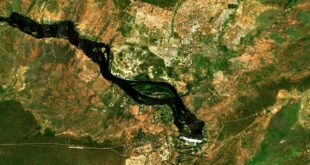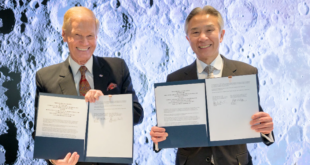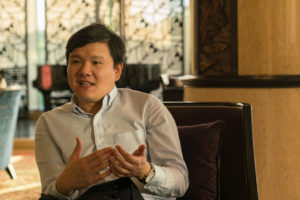
Thai New Space entrepreneur James Yenbamroong, the founder and CEO of mu Space, is emerging as perhaps the preeminent New Space advocate, investor, and role model in Southeast Asia. He has articulated an exciting and bold space vision, is building a solid and cutting edge venture in the form of mu Space, and is now ready to invest in and mentor other budding entrepreneurs in the region with his recent U.S.$100 million venture unit announcement. SpaceWatch.Global sat down with James to talk more about his investment plans and ambitions.
What inspired you to create the venture unit?
From my experience, I see several promising technologies and innovative ideas out there that have the potential to grow. But because of fund limitations, they didn’t come into fruition.
This kind of scenario has inspired me to start a venture unit. I want to support startups or mid-size companies by providing the needed funds to bring their innovative concepts and products to reality.
Is there a geographical scope to the startups you are looking to back?
For now, I’m planning to provide funds to startups and mid-size companies within the Asia-Pacific region. I can always expand to other regions once more funding is available.
What is your strategy for raising the $100 million?
I’ll raise the capital together with private equity and angel investors.
Have you developed investment criteria — or formula even — for startups that might be backed by your venture unit?
I’m still working on the criteria but certainly, the startup should be in the new space or deep tech sector. They should be working to develop new and innovative products or services related to Internet of Things (IoT), artificial intelligence, robotics, space research, or deep space exploration.
The U.S. has a highly developed New Space ecosystem, and there are emerging ecosystems in Europe, China, Japan, and Australia. At what stage of development is the wider Asia-Pacific New Space ecosystem outside of Singapore in your view.
According to a 2017 report from the investment firm Space Angels, about U.S.$3.9 billion of private funds last year had been invested in commercial space activities worldwide. Of that figure, U.S.$3.3 billion (84.6%) was invested in companies based in North America, U.S.$457.9 million (11.7%) in Asia-Pacific, U.S.$133.8 million (3.4%) in Europe, and U.S.$27 million (0.7%) in South America.
From that data, I can say that investment inflow for space-related activities in Asia-Pacific is doing well. I notice, however, that these activities are concentrated in a number of countries like Australia, China, Japan, and Singapore.
We have to change that. The Asia-Pacific has to do more to catch up with the space race.
In Thailand, we’re doing our initial step. The space company I founded, mu Space Corp., will join the space race by launching a satellite and developing space technology for the Asia-Pacific market in the 2020s.
In addition to your $100 million venture unit, what else in your view is required for an Asia-Pacific New Space ecosystem to flourish?
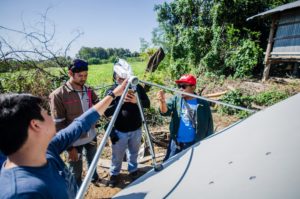
Aside from funds, government support is important to encourage the growth of new space ecosystem. This support can be in the form of having a local policy that can help ease the set up of new space companies, or having well-established digital infrastructures.
What specifically attracts you to Singapore as a base for your venture unit?
Many venture units choose Singapore as their hub. What attracts me with Singapore is the country’s good economy and business ecosystem, well-established digital infrastructures, pro-business local policies, and adequate tech talent pool.
What would have to happen in Thailand for you to base the venture unit in Bangkok?
The location of the venture unit is flexible. It can also be here in Thailand. But, for us to go big and be global, I have to set up the venture in a different location.
A number of economic analysts are warning of economic headwinds in the Asia-Pacific region in the coming months. How much does this concern you, and what measures can you take with your venture unit and criteria for investment top weather possible economic troubles?
You have to learn how to adapt. Economic problems will always be there, regardless of where a company operates. I have to be prepared to face the challenges head-on. Also, having a positive outlook in life is essential.
With regard to mu Space, you’ve spoken recently about sending 100 people to the Moon as a goal in the next ten years – can you elaborate on this vision and any plans you are putting in place?
Famous physicist Stephen Hawking once said: “The survival of the human race is at risk as long as it is confined to a single planet.”
I agree with him. With our dwindling natural and non-renewable resources, it will greatly benefit Earth for humankind to find another suitable habitat in space to save the planet before its resources are depleted.
It’s also possible that we can send the first 100 civilians into space in the next 10 years. Reusable rockets will make spaceflights more affordable in the future and within reach among private citizens.
Similarly, mu Space recently unveiled its spacesuit design. What do you commercially envision for this product, and is it connected to your space tourism ambitions?
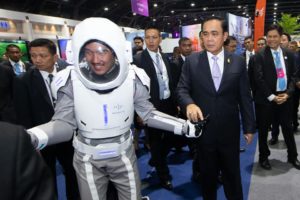
The spacesuit will be initially worn by our space tourism clients.
But we’re also thinking to make the spacesuit more advanced so future astronauts can use it. For this version of spacesuit, we’re going to include features like a helmet visor with a head-up display, a touch-screen wrist display, and an embedded exoskeleton for better mobility in space.
How is mu Space’s core business in creating a SATCOM-based IoT infrastructure in Thailand and beyond progressing?
We’re planning to develop smart apparel that can collect health data. We envision the apparel to gather vital health information of a person, like a body’s temperature, oxygen level, pulse rate, and blood pressure. For this product, we’ll carry out research and tests at the IoT Institute in Thailand, which will be completed in 2020.
Lastly, you espouse an exciting and interesting vision for space and human spaceflight in Southeast Asia – what else do you have up your sleeve?
We’ll have more space-related activities to be doing next year. I’ll share the information once our plans become more clear.


